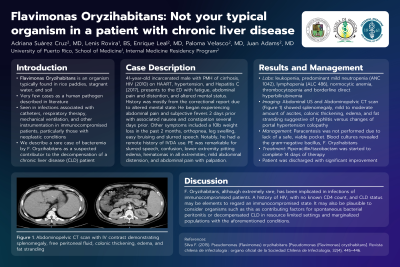Back


Poster Session B - Monday Morning
Category: Liver
B0572 - Flavimonas Oryzihabitans: Not Your Typical Organism in a Patient With Chronic Liver Disease
Monday, October 24, 2022
10:00 AM – 12:00 PM ET
Location: Crown Ballroom

Has Audio

Adriana I. Suarez Cruz, MD
University of Puerto Rico School of Medicine, Internal Medicine Program
San Juan, PR
Presenting Author(s)
Adriana I. Suarez Cruz, MD1, Lenis Rovira Torres, 2, Enrique Leal Alviarez, MD3, Paloma Velasco, MD4, Juan J. Adams Chahin, MD5
1University of Puerto Rico School of Medicine, Internal Medicine Program, San Juan, Puerto Rico; 2University of Puerto Rico School of Medicine, San Juan, Puerto Rico; 3University of Puerto Rico Hospital, San Juan, Puerto Rico; 4University of Puerto Rico, Internal Medicine Program, San Juan, Puerto Rico; 5University of Puerto Rico Medical Sciences Campus, San Juan, Puerto Rico
Introduction: Flavimonas Oryzihabitans is an organism typically found in rice paddies, stagnant water, and soil. There have been very few cases as a human pathogen described in literature. It has been seen in infections associated with catheters, respiratory therapy, mechanical ventilation, and other instrumentation in immunocompromised patients, particularly those with neoplastic conditions. We describe a rare case of a bacteremia by F. Oryzihabitans as a suspected contributor to the decompensation of a chronic liver disease (CLD) patient.
Case Description/Methods: A 41-year-old incarcerated male with PMH of cirrhosis, HIV (2010) on HAART, hypertension, and Hepatitis C (2017), presents to the ED with fatigue, abdominal pain and distention, and altered mental status. History was mostly from the correctional report due to altered mental state. He began experiencing abdominal pain and subjective fevers 2 days prior with associated nausea and constipation several days prior. Other symptoms included a 10lb weight loss in the past 2 months, orthopnea, leg swelling, easy bruising and slurred speech. Notably, he had a remote history of IVDA use. PE was remarkable for slurred speech, confusion, lower extremity pitting edema, hematomas in all extremities, mild abdominal distension, and abdominal pain with palpation. Laboratory workup was notable for leukopenia, predominant mild neutropenia (ANC 1042), lymphopenia (ALC 486), normocytic anemia, thrombocytopenia and borderline direct hyperbilirubinemia. Abdominal US and Abdominopelvic CT scan (Figure 1) showed splenomegaly, mild to moderate amount of ascites, colonic thickening, edema, and fat stranding suggestive of typhlitis versus changes of portal hypertension colopathy. Paracentesis was not performed due to lack of a safe, viable pocket. Yet, blood cultures revealed a gram-negative bacillus, Flavimonas Oryzihabitans. Piperacillin/ tazobactam was started to complete 14 days of therapy, and later, he was discharged with significant improvement to continue therapy for his chronic conditions.
Discussion: Flavimonas Oryzihabitans, although extremely rare, has been implicated in infections of immunocompromised patients. A history of HIV, with no known CD4 count, and CLD status may be elements to regard an immunocompromised state. It may also be plausible to consider organisms such as this as contributing factors for spontaneous bacterial peritonitis or decompensated CLD in resource limited settings and marginalized populations with the aforementioned conditions.

Disclosures:
Adriana I. Suarez Cruz, MD1, Lenis Rovira Torres, 2, Enrique Leal Alviarez, MD3, Paloma Velasco, MD4, Juan J. Adams Chahin, MD5. B0572 - Flavimonas Oryzihabitans: Not Your Typical Organism in a Patient With Chronic Liver Disease, ACG 2022 Annual Scientific Meeting Abstracts. Charlotte, NC: American College of Gastroenterology.
1University of Puerto Rico School of Medicine, Internal Medicine Program, San Juan, Puerto Rico; 2University of Puerto Rico School of Medicine, San Juan, Puerto Rico; 3University of Puerto Rico Hospital, San Juan, Puerto Rico; 4University of Puerto Rico, Internal Medicine Program, San Juan, Puerto Rico; 5University of Puerto Rico Medical Sciences Campus, San Juan, Puerto Rico
Introduction: Flavimonas Oryzihabitans is an organism typically found in rice paddies, stagnant water, and soil. There have been very few cases as a human pathogen described in literature. It has been seen in infections associated with catheters, respiratory therapy, mechanical ventilation, and other instrumentation in immunocompromised patients, particularly those with neoplastic conditions. We describe a rare case of a bacteremia by F. Oryzihabitans as a suspected contributor to the decompensation of a chronic liver disease (CLD) patient.
Case Description/Methods: A 41-year-old incarcerated male with PMH of cirrhosis, HIV (2010) on HAART, hypertension, and Hepatitis C (2017), presents to the ED with fatigue, abdominal pain and distention, and altered mental status. History was mostly from the correctional report due to altered mental state. He began experiencing abdominal pain and subjective fevers 2 days prior with associated nausea and constipation several days prior. Other symptoms included a 10lb weight loss in the past 2 months, orthopnea, leg swelling, easy bruising and slurred speech. Notably, he had a remote history of IVDA use. PE was remarkable for slurred speech, confusion, lower extremity pitting edema, hematomas in all extremities, mild abdominal distension, and abdominal pain with palpation. Laboratory workup was notable for leukopenia, predominant mild neutropenia (ANC 1042), lymphopenia (ALC 486), normocytic anemia, thrombocytopenia and borderline direct hyperbilirubinemia. Abdominal US and Abdominopelvic CT scan (Figure 1) showed splenomegaly, mild to moderate amount of ascites, colonic thickening, edema, and fat stranding suggestive of typhlitis versus changes of portal hypertension colopathy. Paracentesis was not performed due to lack of a safe, viable pocket. Yet, blood cultures revealed a gram-negative bacillus, Flavimonas Oryzihabitans. Piperacillin/ tazobactam was started to complete 14 days of therapy, and later, he was discharged with significant improvement to continue therapy for his chronic conditions.
Discussion: Flavimonas Oryzihabitans, although extremely rare, has been implicated in infections of immunocompromised patients. A history of HIV, with no known CD4 count, and CLD status may be elements to regard an immunocompromised state. It may also be plausible to consider organisms such as this as contributing factors for spontaneous bacterial peritonitis or decompensated CLD in resource limited settings and marginalized populations with the aforementioned conditions.

Figure: Figure 1. Abdominopelvic CT scan with IV contrast demonstrating splenomegaly, free peritoneal fluid, colonic thickening, edema, and fat stranding
Disclosures:
Adriana Suarez Cruz indicated no relevant financial relationships.
Lenis Rovira Torres indicated no relevant financial relationships.
Enrique Leal Alviarez indicated no relevant financial relationships.
Paloma Velasco indicated no relevant financial relationships.
Juan Adams Chahin indicated no relevant financial relationships.
Adriana I. Suarez Cruz, MD1, Lenis Rovira Torres, 2, Enrique Leal Alviarez, MD3, Paloma Velasco, MD4, Juan J. Adams Chahin, MD5. B0572 - Flavimonas Oryzihabitans: Not Your Typical Organism in a Patient With Chronic Liver Disease, ACG 2022 Annual Scientific Meeting Abstracts. Charlotte, NC: American College of Gastroenterology.
